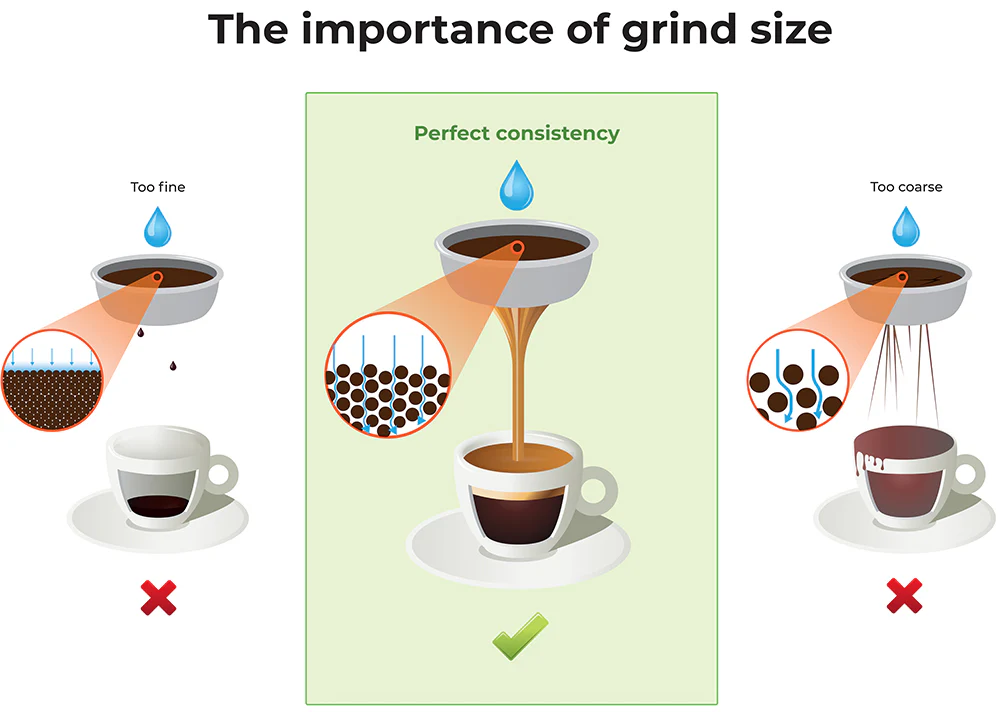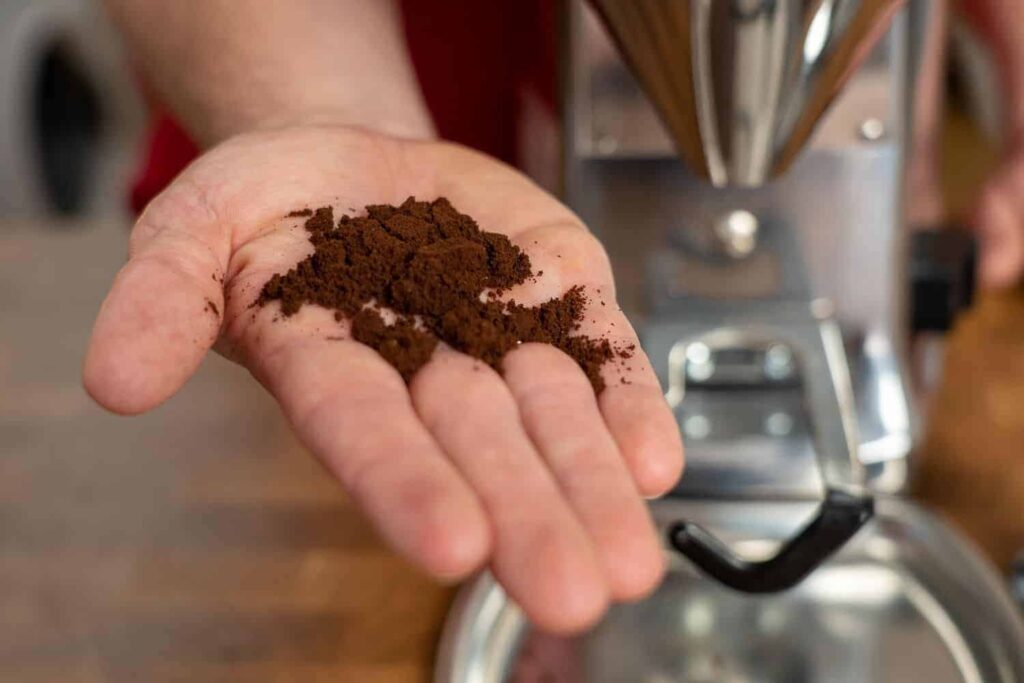In espresso brewing, grind size isn’t just a detail—it’s a major variable that determines whether your shot is balanced, bitter, or sour. Even with high-end machines, top-tier beans, and perfect dosing, a misaligned grind size can throw your extraction off completely. Understanding grind size impact on espresso quality is essential for mastering your brewing game.
In this guide, we’ll break down how grind size for espresso impacts the quality, flow rate, extraction yield, flavor balance, and consistency. You’ll learn how to dial it in like a pro—and what signs to watch for when it’s off.

Why Grind Size for Espresso Matters in Brewing
Espresso’s Need for Precision
Unlike other brewing methods, espresso relies on pressure, time, and fine grinds to extract flavors in under 30 seconds. A grind that’s too coarse will let water rush through, under-extracting the coffee. Too fine, and the flow will choke, leading to over-extraction or bitter shots.

Grind size directly affects extraction time, flavor profile, and texture. Espresso needs a fine grind—finer than table salt but not quite powdery like flour. That perfect middle ground gives water enough time to extract the oils, acids, and sugars that make espresso magical.
The Grind Size Impact on Espresso Quality & Preparation
If you’ve ever sipped on a lackluster espresso, chances are the grind size played a major role in that disappointment. Grind size is one of the most critical factors in the espresso-making process, directly influencing the quality, extraction, and overall flavor of your brew. Understanding this variable can elevate your espresso game from ordinary to extraordinary.
Extraction Explained: Extraction is the process of pulling flavors, oils, and aromas from the coffee grounds using hot water. The grind size directly affects this process. A finer grind increases the surface area exposed to water, speeding up extraction. Conversely, a coarser grind slows it down. This balance is crucial because it determines how much flavor is extracted from the coffee grounds. Proper extraction ensures that you get a full-bodied, aromatic, and flavorful espresso.
Quality Matters: When it comes to espresso, quality is everything. The grind size can make the difference between a rich, flavorful shot and a bitter or weak disappointment. Too fine a grind, and your espresso can be over-extracted, leading to a bitter, unpleasant taste. Too coarse, and it can be under-extracted, resulting in a weak, sour shot. Finding that sweet spot is essential for achieving the perfect balance of flavors.
Flavor Explosion: The ultimate goal of any espresso lover is to savor that perfect shot, rich with complex flavors. The grind size can either enhance or mask these flavors. With the right grind, you can highlight the coffee’s natural sweetness, acidity, and bitterness in a harmonious blend. A consistent grind size ensures uniform extraction, allowing each sip to deliver a balanced and enjoyable taste experience.
The Ideal Grind Size for Espresso


Espresso requires a grind consistency between table salt and powdered sugar. This texture allows enough resistance for 9 bars of pressure to evenly extract solubles from the coffee bed.
Using a Burr Grinder vs Blade Grinder

- Burr grinders provide uniformity, essential for espresso
- Blade grinders produce uneven particles = uneven extraction
How Grind Size Affects Flow Rate and Extraction

Coarse Grinds = Fast Flow, Under-Extraction
- Symptoms: Sour, watery, weak body, pale crema
- Cause: Water passes too quickly, doesn’t dissolve enough coffee solids
Fine Grinds = Slow Flow, Over-Extraction
- Symptoms: Bitter, dry finish, choking shot
- Cause: Too much resistance slows extraction, extracting too many bitter compounds
Want a quick analogy? Grind too coarse = drinking sour tea. Grind too fine = chewing charcoal. Nail the grind? That’s espresso bliss. Want to know how to get the perfect grind size? See it here.
Common Mistakes and Fixes
Even seasoned baristas and homebrewers can encounter issues with grind size that negatively impact espresso quality. Identifying and correcting these common mistakes can significantly improve your espresso. Here are some practical tips and solutions to help you troubleshoot and achieve the perfect shot.
1. Grind Size Too Fine
Symptoms:
- Bitter and harsh flavor
- Slow extraction time (over 30 seconds)
- Espresso puck is overly compact and difficult to remove
Fixes:
- Adjust the Grind Size: Move to a slightly coarser grind. This will allow water to flow more freely, reducing extraction time and bitterness.
- Monitor Extraction Time: Aim for an extraction time of 25-30 seconds. Adjusting the grind size should help achieve this balance.
2. Grind Size Too Coarse
Symptoms:
- Sour and acidic flavor
- Fast extraction time (under 20 seconds)
- Espresso puck is loose and watery
Fixes:
- Adjust the Grind Size: Shift to a finer grind. This increases surface area, slowing down the extraction and enhancing flavor.
- Monitor Extraction Time: Aim for an extraction time of 25-30 seconds. A finer grind should help achieve this ideal range.
3. Inconsistent Grind Size
Symptoms:
- Uneven extraction (some parts of the puck are over-extracted, others are under-extracted)
- Mixed flavors (bitter and sour notes in the same shot)
- Inconsistent crema
Fixes:
- Use a Quality Grinder: Invest in a burr grinder, which provides a more consistent grind compared to blade grinders.
- Calibrate Your Grinder: Regularly check and adjust your grinder settings to ensure consistency.
Dialing In Your Espresso Grind

Start with a Baseline
- Use a 1:2 brew ratio (e.g., 18g in, 36g out)
- Aim for a 25–30 second extraction
- Taste and adjust
Adjusting Based on Taste
- Sour or weak? Grind finer
- Bitter or dry? Grind coarser

Other Factors That Influence Grind Adjustment
Bean Age and Roast Level
- Fresh beans (3–7 days post-roast): More gas, require coarser grind
- Older beans: Less resistance, may need finer grind
- Dark roasts: Softer, may choke the machine—go coarser
- Light roasts: Dense, require finer grind
Environment (Humidity, Temperature)
Humidity affects moisture absorption, which can slow or speed up flow—forcing you to adjust grind daily in some climates.

Espresso Grinder Features That Help
Stepless vs Stepped Adjustments
- Stepless: More control, ideal for espresso
- Stepped: Simpler but less precise

Grind Retention and Purging
Leftover grinds affect your next shot. Always purge a few grams after an adjustment.

Visual and Sensory Cues to Dial In

Crema Thickness
- Pale, bubbly = under-extracted
- Tiger-striped, caramel = ideal
- Dark, thin = over-extracted
Puck Quality
- Even, dry puck = balanced shot
- Wet, soupy puck = channeling or wrong grind

Troubleshooting Common Grind Problems
- Problem Symptom Solution
- Too coarse Sour shot, fast flow Grind finer
- Too fine Bitter, choking shot Grind coarser
- Inconsistent flow Spraying, mess Improve distribution, WDT
- Clumps Uneven extraction Use anti-static grinder or declump tool

Final Thoughts: Grind Size Is the Heart of Espresso

Your espresso shot lives and dies by grind size. Even small changes in grind can have massive effects on flavor, body, and extraction consistency.
By learning to dial in your grind, adjust based on bean age, roast level, and weather conditions, you gain control over your coffee’s flavor profile. Mastering grind size is the first true step in becoming a home or professional barista.
Written by Jose Luis Surjan
Espresso & Latin Food Expert






